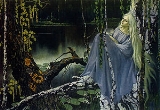
Semik
Encyclopedia
Semik is an ancient Slavic
fertility festival celebrated in early June and closely linked with the cult of the dead and the spring agricultural rites. It usually fell upon the Thursday of the Green Week (better known as Trinity Week in Russia and the Whitsuntide week in Britain). Its name is derived from the Slavic word for "seven", because the Green Week was the seventh (sometimes the eighth) week after Easter
. The end of Semik inaugurated the celebrations of the Trinity Sunday
.
The Rusalki were believed to be at their most dangerous during the Green Week (Russian: русальная неделя), and were supposed to have left their watery depths in order to swing on branches of birch and willow trees at night. Peasant women sometimes hung offerings to appease them. A cross, a magic circle, incense, garlic, wormwood, a pin or poker and verbal charms were used to render the rusalki harmless. Swimming was strictly forbidden, lest mermaids would drag the swimmer down to the river floor.
On Semik, funeral services were held for those who had not received a proper burial. Peasants decorated the insides and outsides of their houses with birch branches, and they selected a birch tree to decorate with ribbons and beads. The birch was usually left in the forest, but was sometimes brought into the village. The birch (referred to as "semik", just like the holiday itself) was seen as a symbol of vegetative power and stood as a focal point for girls' singing and dancing. Vows of eternal friendship were made here. Like Kostroma during Maslenitsa
, this fertility symbol was destroyed at the end of the festivities. Usually, it was drowned "in order to provide the needed rainfall for the sprouting crops".
Slavic Europe
Slavic Europe is a region of Europe where Slavic languages are spoken. This area is situated in Central and Eastern Europe and the Balkans, and includes the nations of Belarus, Bosnia and Herzegovina, Bulgaria, Croatia, the Czech Republic, the Republic of Macedonia, Montenegro, Poland, Russia,...
fertility festival celebrated in early June and closely linked with the cult of the dead and the spring agricultural rites. It usually fell upon the Thursday of the Green Week (better known as Trinity Week in Russia and the Whitsuntide week in Britain). Its name is derived from the Slavic word for "seven", because the Green Week was the seventh (sometimes the eighth) week after Easter
Easter
Easter is the central feast in the Christian liturgical year. According to the Canonical gospels, Jesus rose from the dead on the third day after his crucifixion. His resurrection is celebrated on Easter Day or Easter Sunday...
. The end of Semik inaugurated the celebrations of the Trinity Sunday
Trinity Sunday
Trinity Sunday is the first Sunday after Pentecost in the Western Christian liturgical calendar, and the Sunday of Pentecost in Eastern Christianity...
.
The Rusalki were believed to be at their most dangerous during the Green Week (Russian: русальная неделя), and were supposed to have left their watery depths in order to swing on branches of birch and willow trees at night. Peasant women sometimes hung offerings to appease them. A cross, a magic circle, incense, garlic, wormwood, a pin or poker and verbal charms were used to render the rusalki harmless. Swimming was strictly forbidden, lest mermaids would drag the swimmer down to the river floor.
On Semik, funeral services were held for those who had not received a proper burial. Peasants decorated the insides and outsides of their houses with birch branches, and they selected a birch tree to decorate with ribbons and beads. The birch was usually left in the forest, but was sometimes brought into the village. The birch (referred to as "semik", just like the holiday itself) was seen as a symbol of vegetative power and stood as a focal point for girls' singing and dancing. Vows of eternal friendship were made here. Like Kostroma during Maslenitsa
Maslenitsa
Maslenitsa . Maslenitsa corresponds to the Western Christian Carnival, except that Orthodox Lent begins on a Monday instead of a Wednesday. The Orthodox date of Easter can differ greatly from the Western Christian date. In 2008, for example, Maslenitsa was celebrated from March 2 to March...
, this fertility symbol was destroyed at the end of the festivities. Usually, it was drowned "in order to provide the needed rainfall for the sprouting crops".
Links
- Semik (Green Svyatki) // Russian Museum of Ethnography
- Rusalka Week // Russian Museum of Ethnography

